by Tom Gaylord
Writing as B.B. Pelletier
This report covers:
- Adjust the reg.
- What’s next?
- Beeman Kodiaks
- JSB Exact Jumbo Heavy
- Velocity
- Baracudas on the lowest setting
- JSB Exact Jumbo Heavy on the lowest setting
- Dae Sung on the lowest setting
- Discussion
- A special test
- Shot count
- Trigger adjustment
- Summary
Today I lower the regulator pressure setting and see what kind of performance we get with the Air Venturi Avenger. Because the regulator is user-adjustable and the hammer spring is also adjustable, the Avenger is flexible in its power settings. Today I hope we will determine the lower limit of that range, but because of the hammer spring adjustment there is a lot more to test. I will tell you everything I do, but I may not be able to test each and every possible combination, if the regulator settings and hammer spring adjustments have too wide a spread.
Adjust the reg.
First things first. Before you adjust the regulator you must first exhaust all the air in the reservoir. I read the manual carefully before proceeding. I was surprised that the Allen wrench that was included with the rifle wasn’t the right size for the air bleed screw. The wrench they sent is 2.5mm. It adjusts the hammer spring tension fine. We did that in Part 2. But the bleed screw needs a 3mm wrench.
Once that was resolved I carefully turned the screw counter-clockwise. The manual says not to turn it out more than 2 turns, but I found only a quarter turn was needed. The air exhausted from 2,000 psi to zero in about three minutes. The reg. gauge was also reading zero at this point.
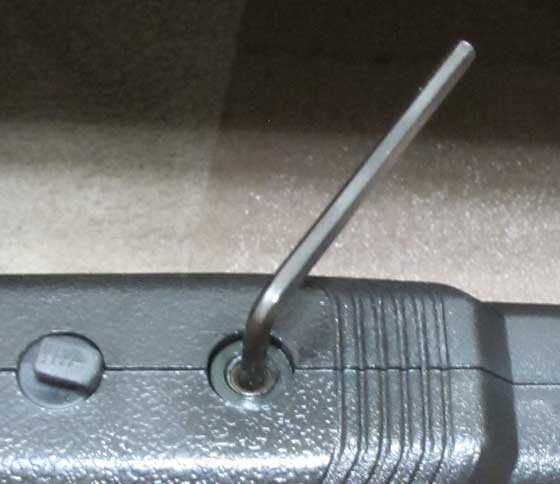
The 3mm air bleed screw only needed a quarter turn to exhaust the air from the reservoir. The rubber plug on the left of the bleed screw hides the regulator adjustment screw.
Now the regulator can be adjusted. I read the manual for this, as well. To adjust the reg. they recommend you turn it as low as it will go, which is clockwise, until the screw stops. Then turn the screw back a quarter turn.
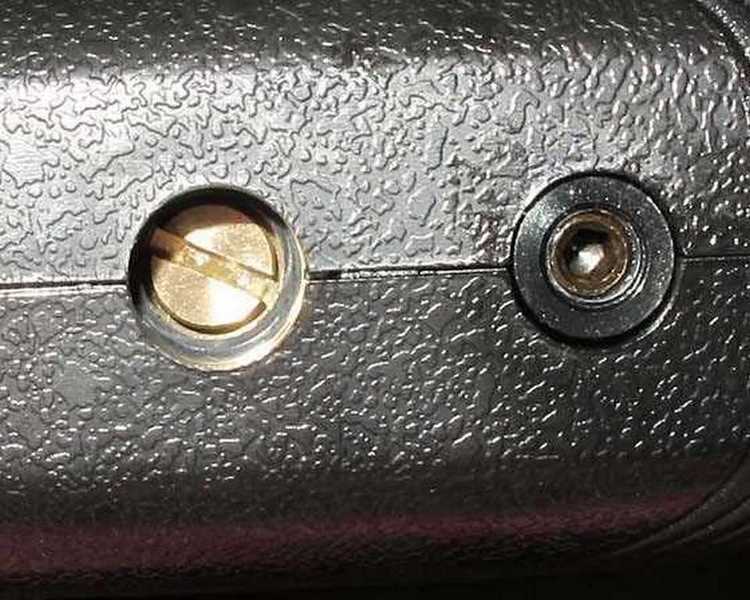
Turn the brass reg. adjustment screw clockwise until it stops, then a quarter turn back.
Now, fill the reservoir to 300 bar. When I did I noticed that the reg. gauge needle stopped in the yellow, just below the recommended minimum setting.
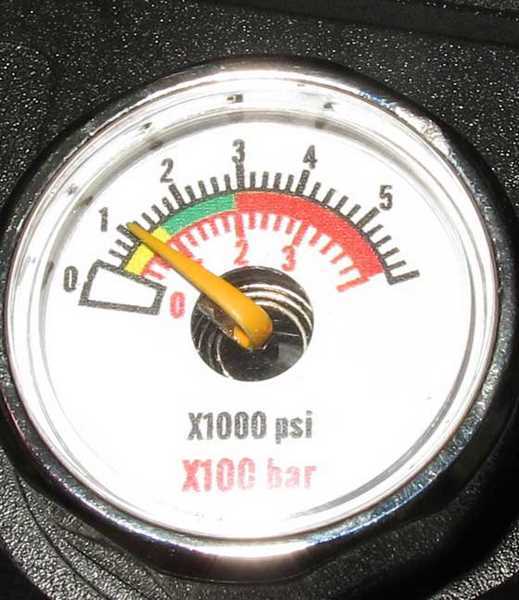
After the reservoir was filled to 300 bar and allowed a few minutes to settle, the regulator gauge read like this.
The manual says to open the regulator adjustment (a counter-clockwise turn of the screw) slowly and allow the gauge time to catch up. I will say to do this EXTREMELY slowly, because even a slight movement of the screw affects the setting! I probably turned the screw 8 times, but I kept my eyes glued to the gauge needle, because I did not want to go through the process of draining and refilling the reservoir again. All those tiny adjustments probably turned the screw a total of another quarter turn and got the needle up to the start of the green area.
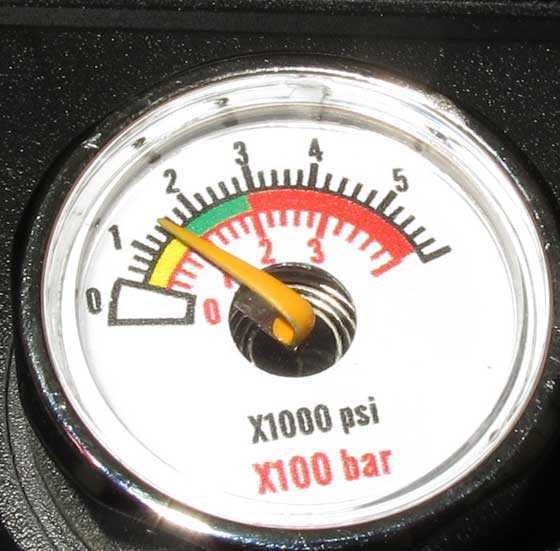
After all my adjustment the reg. gauge now reads like this. Two hours later the gauge was still in the same place.
What’s next?
Now that the regulator has been set to its lowest setting, I can either shoot the rifle for velocity with the hammer spring set to its highest tension, which it is at this time. I adjusted it up all the way in the last test. Or I could adjust it as low as it will go. I decided on the first thing — leave it set as high as it will go — and see where the regulator adjustment has taken us.
We learned in Part 2 that regardless of the pellet used, the power stayed pretty much in the same place — 36 and a fraction foot-pounds. What will it do now that the regulator is set to the lowest pressure it can function at. with the hammer spring set as high as it will go? For this test I only shot a few of two different pellets.
Beeman Kodiaks
The 21.14-grain Beeman Kodiaks gave the following string.
Shot……….Vel.
1……………790
2……………747
3……………750
4……………749
5……………753
6……………751
The first shot was high because the gun sat awhile and the reg filled. But the average of the 5 shots after that is 750 f.p.s. For this pellet that gives a muzzle energy of 26.41 foot-pounds with a velocity spread of 6 f.p.s. In the previous test the average energy for this pellet was 36.94 foot-pounds, so with the reg set as low as it will go and the hammer at the highest possible setting the power range is just over 10 foot-pounds or 37 f.p.s.
That tells us a lot about the Avenger. That will make the rest of today’s test much easier, because there isn’t that much more to test.
JSB Exact Jumbo Heavy
This was also shot with the reg. on low and the hammer at its highest. A short string of 18.13-grain JSB Exact Jumbo Heavy pellets gave me the following.
Shot……….Vel.
1……………802
2……………798
3……………793
4……………795
5……………794
The average for this string is 796 f.p.s. which gives an average of 25.51 foot-pounds, compared to the 36.65 foot-pounds average (at 954 f.p.s.) in the previous test.
Velocity
In the comments to Part 1 Tyler Patner told reader RidgeRunner,
“The reg. is adjustable up to 3000 PSI (recommended maximum) but it can go a bit higher than that. I found there’s plenty of room to adjust the reg down and still maintain similar power levels to where it comes set from the factory.”
Hammer spring set to the lowest
Now I adjusted the hammer spring tension as low as it would go. That was three full turns of the adjustment screw counter-clockwise. Now both the reg. and the hammer are set as low as they will go. Let’s see what that does.
Baracudas on the lowest setting
Ten Baracudas averaged 722 f.p.s. on this setting. The spread went from 714 to 730 f.p.s., a difference of 16 f.p.s. The muzzle energy was 24.48 foot-pounds. Therefore, the power range of this pellet in the Avenger ranges from a low of 24.48 foot pounds to a high of 36.94 foot-pounds.
JSB Exact Jumbo Heavy on the lowest setting
Ten JSB Exact Jumbo Heavys averaged 782 f.p.s. at this setting. The spread went from 775 to 790 f.p.s., a difference of 15 f.p.s. That’s an average 24.62 foot-pounds at the lowest setting, compared to 36.65 foot-pounds at the highest setting.
Dae Sung on the lowest setting
Next I shot the 28.9-grain Dae Sung domes. At this lowest setting they averaged 593 f.p.s. with a low of 588 and a high of 610 f.p.s. — a spread of 24 f.p.s. At this velocity they averaged 22.57 foot pounds of energy, compared to 36.98 foot-pounds at the highest setting. This power spread is a little broader, but still biased toward high power.
Discussion
The Avenger has a narrow range of power adjustability. It’s capable of hunting power in all settings. But at the lowest power setting how many more shots can we expect? In the last test where the highest power was set we got about 55 good shots. From this point on all shots will be with JSB Exact Jumbo Heavys. I have already shot 11 shots with the hammer spring set at its highest, but the power doesn’t seem to be that much different.
A special test
Given the three strings at the lowest hammer spring setting, a total of 41 shots have been fired so far. I had noticed that the first shot in every string was faster if I waited a minute between strings. So, for the next 10 shots I waited a minute between shots to allow the regulator to fill. Remember — these are JSB Jumbo Heavys from here on.
Shot……….Vel.
42………….783
43………….783
44………….776
45………….781
46………….781
47………….776
48………….774
49………….778
50………….777
51………….779
The average for that string was 779 f.p.s. And the spread was only 9 f.p.s. Since hunters wait a long time between most shots, they should also wait long between shots when sighting in with most regulated guns.
Shot count
We got about 55 shots on a fill in the last test at the highest power. Now that the reg. and hammer spring have been dialed as low as they will go, how many shots are available?
Shot 52 went out at 776 f.p.s. Shot 61 was 773 f.p.s. Shot 70 was 773 f.p.s. Shot 75 was 768 f.p.s,. and then I waited 5 minutes before shot 76. Shot 76 went out at 782 f.p.s.
Shot 81 was 763 f.p.s. The pressure on the reservoir gauge read just under 2,000 psi remaining and the regulator gauge still reads the same as when the test was started.
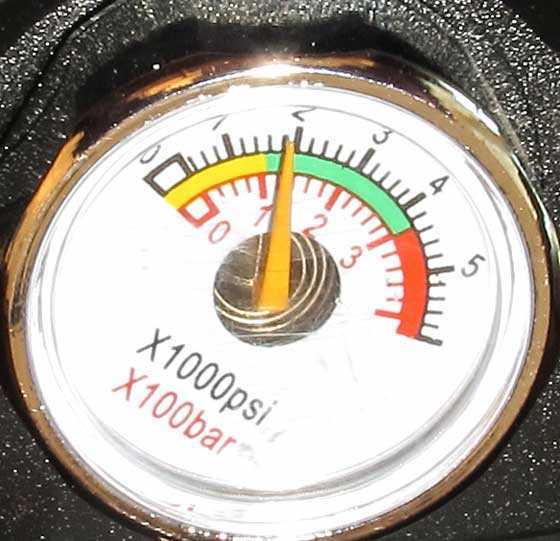
After 81 shots at the lowest possible power setting the gauge reads just under 2,000 psi. The reg. gauge still reads 1,500 psi.
Shot 90 was 760 f.p.s. Shot 96 was 757 f.p.s. and I stopped shooting at that point. The reservoir gauge now reads 1,400 psi and the regulator gauge has now dropped back to that pressure as well.
So, the Avenger gets a lot of powerful shots on all power settings. I think I will leave it set where it is for the rest of my tests. It has plenty of power right now and it really uses air well. We shall see.
Trigger adjustment
The trigger was set pretty nice from the factory. It’s two-stage and not that heavy (that’s in Part 2). But stage two has some creep so I thought I would try to fix it.
Unfortunately the manual shows a trigger sear adjustment screw that’s not on the test rifle. It adjusts the amount of sear contact, so that’s probably a good idea because too little contact can lead to an unplanned discharge.
I adjusted the trigger pull weight screw and seem to have fixed the problem of creep. Maybe when I do the accuracy test I will have more to say about the trigger.
Summary
The Air Venturi Avenger is testing to be a very nice, powerful PCP with some features few other airguns offer. The power range is narrow, which makes this rifle good for hunting and, if accurate enough, for long range target shooting. Don’t forget it also comes in .177 and .25 calibers.
In the next test we will see how accurate it is. I am looking forward to that.

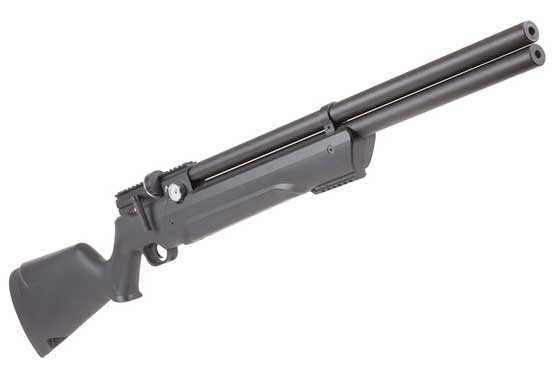
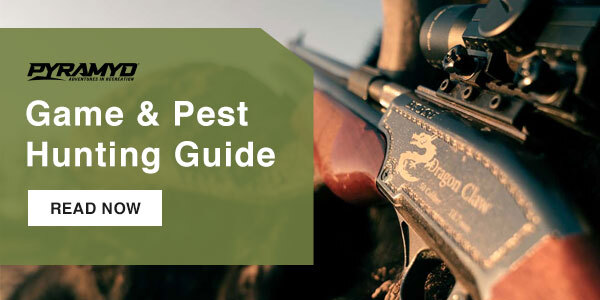
Yesterday we were talking about a good springer for the fraction of the cost of the existing good ones.
Is it possible that we now look at an existing equivalent case in pcp? It would be very interesting to compare it with, say, the new FX Dreamline.
Good morning to you all.
Bill
Bill,
The Avenger is certainly testing out quite well. Alkl that remains is accuracy. If it is accurate, and everything I have heard says it is, then it is a real wiunner!
B.B.
I confess that I just took a peak at Tyler’s review. A winner for certain.
Bill
Bill,
It was Tyler who called me and recommended that I test one right away. I see now why he did!
B.B.
Bill,
The FX Dreamlite in .177 did not do well in BB’s hands. I had the opportunity shortly after that to shoot the FX Dreamlite in .25 using three different JSB pellets. I was quite disappointed in the performance of all three at fifty yards. In all fairness I personally believe that with some time and a little tuning the performance will increase from a 2 MOA air rifle to close to a 1 MOA air rifle.
Food for thought.
For the price of one Dreamline you can buy three Avengers, one in each caliber, AND one decent scope. From the testing I have seen the Avenger is approaching 1 MOA out of the box.
My opinion. Not yours.
RR
I believe that my thinking about ASP/SPA project can be re-evaluated now… Or for any other QUALITY airgun we may get for a decent price, regardless of countries.
Bill
Bill,
In my most humble opinion (IMMHO) the Diana/SPA airguns are not quite there yet. All that I have heard, seen or read concerning the Nova Vista airguns has been positive. The Freedom/Aspen and now the Liberty/Avenger reviews have shown that these air rifles are equal in performance and reliability of much higher priced air rifles if not in outstanding quality.
No matter how well built it is, if it is not accurate, it is not interesting.
B.B.,
This rifle seems to be hitting all the right notes. Good range of adjustment. Regulator just needs a little more breaking in.
Siraniko
PS: Section Shot count First sentence: “I aWe (I or We) got about 55 shots on a fill in the last test at the highest power.”
Siraniko,
Fixed it. Thanks, as always,
B.B.
BB,
You and others have finally managed to convince me that I want a Chinese air rifle. Not just any Chinese air rifle. That Chinese air rifle. Despite myself, I had been seriously looking at the Nova Vista Liberty from which this has been developed. Here they have taken the Liberty to the next step. I like the styling. I like the adjustability. I am certain we all are going to like the accuracy.
If it had a shot counter it would be perfect. 😉
Blooper alert!
Just below the last picture.
The reservoir gauge now reads 1,400 psi and the reservoir (regulator) gauge has now dropped back to that pressure as well.
RR,
fixed it. Thanks,
B.B.
RR
But it does have a shot counter. 😉
B.B.
Sentence in Adjust regulator, Before you adjust the regulator you much (must) first exhaust all the air in the reservoir.
Dan
Dan,
I got it. Phooey on my lack of editing!
B.B.
Hi B.B.,
This is looking really good with the regulator pressure dialed back from higher levels. You could lower it even more for lighter pellets.
May I recommend trying the JSB 14.3 gr pellet in this rifle? This has been an excellent performer in my .22 cal PCP’s.
If I have got it correctly, I believe the method of operation to find the most efficient set up for a given pellet is to first adjust the regulator pressure, then increase the hammer spring tension incrementally until the velocity no longer increases, then back the tension off a little. This requires a chronograph, of course. Then, of course, for the ultimate in fine-tuning, you check accuracy and if not ideal, raise or lower the regulator pressure and repeat until you get the best accuracy for that pellet.
Thanks for all your hard work with these reports, still my first go-to airgun page every morning.
Regards,
Feinwerk
Whats not to like….Hollow stock, I can live with that …Not made locally, I can live with that… No shot counter,I can live with that. Just too many good points verses not so good points
Rk,
The rear stock can be filled with foam. You may be able to add a little foam padding around the additional air reservoir located inside the fore stock.
Made in China. I have a personal thing about that, but I am slowly being forced to overlook it.
Not having a shot counter is a bit of an issue because of my poor mathematical skills, but I may be able to overlook that. Maybe.
B.B.
Interesting, will be watching the accuracy testing with curiosity.
The range of adjustment on the Avenger is pretty good – nice gain in shot count. Like “tunable” rifles – so much fun to tweak!
When adjusting my PCPs I like a setup that is just off the flat part of the power graph where the valve seems happiest (minimum spread and very consistent). To get there I chose a reg set-point and a low to mid Hammer Spring (HS) tension then increase the HS testing velocities as I go. When I reach the maximum velocity for that particular set-point (increasing the HS no longer increases the velocity) I back off the HS so that I am on the “knee” of the power curve – at about 93 to 95% of the max velocity.
Now that things are stable I test for groups to see if the pellet and rifle are happy with that particular velocity; if not I change the reg set-point and try again – fun stuff! I can usually peg the right velocity pretty quick. For .22 15.89 g JSB pellets it is (usually) in the 880 to 920 fps range (for hunting) though I will tune to lower velocities for (quiet) back-yard pesting or increased shot-count for my plinking rifles.
My Impact has a valve-dwell adjustment which is very nice for fine tuning, wish my other PCPs had that feature.
Cheers!
Hank
BB,
Things are looking real good with this one. I think that if I had it,… I would tune it to a 3000 fill. I even have a Guppy tank and a Shoebox.
Chris
Chris
Funny.
Tune it to a 3000 psi fill???
GF1,
For the shot count and power you want/need before it drops off the reg.. Obviously,… a higher fill will yield more shots. 4000 something is just ridiculous in my book. The exception might be a big bore in which you want 4 shots instead of 2.
Chris
Chris
Why would you tune to 3 or 4000 psi.
When you say that it makes it seem like you mean to adjust the regulator to those working pressures.
The lower the regulated set pressure is and the gun can still shoot with adequate power and is accurate. That’s when the regulator is set right. The lower that pressure is the more shot count you have per 3 or 4000 psi fill.
Now that gun can be filled anywhere from what the regulated pressure is up to the 3 or 4000 psi.
I think that’s what you mean.
GF1,
I would fill to 3000 so as not to tax the tank and compressor. I would then find a tune that had the shot count and power that I could live with.
At a 4000+ fill,… my little guppy tank might only top the gun off once or twice.
Also,… while I am sure that there is a significant safety margin built into air gun air tubes,… it seems that they are diving into that safety margin in order to increase shot count. As I recall,.. failures are at the threaded fittings most of the time anyways,… be it a tank, whip or fitting.
I do not see 4000+ as practical for the average user. Plus,.. with this one,.. there seems to be no need with the ability to tune and still get plenty of shot count and power. The “shot count war” seems to be falling right in with the fps war of long. What is next?,…. 5000?, 6000? when there is compressors and tanks that will do it? Do you really need 200+ shots before filling?
Chris
Chris
I see what you mean now.
But keep this in mind. If the manufacturer states that their gun can be filled to 3500 or 4000 psi then they probably have the gun built to work at those pressures.
And here’s something to think about. And this is why the option to fill to 4000 psi with a regulated gun and it can get 200+ shots on a fill is something that interest me.
Let’s say I go out to my brothers to shoot for a while or even the day if we was shooting different guns throughout the day. I could bring that gun and not worry about bringing support equipment for the day. And that’s a good thing.
BB
Off subject. Cyberspace won’t let me reply to your question you asked today at 4:31 am normally.
Deck,
Thanks for this comment. Is the first scope perhaps adjusted past thge halfway mark foir elevation?
B.B.
This was from the A Little About O Rings report. My answer to your question is both vertical and windage turrets were turned well past the middle of range adjustment. Spring tension was about 1/4 from the maximum. I thought about increasing tension to maximum and using a fully adjustable mount to zero the scope. Another option is to use it as a spotter scope.
Deck
Deck,
Well, that will do it. Few scopes can hold a zero that far up or right.
B.B.
BB
I am confused but that happens. Your reply seems to imply my turret adjustments were on the weak side of center. The opposite is true. My long time fiddling with scopes and reading your blog for 6 years had me convinced that weak spring tension settings invited target POI problems. We probably are in agreement except I’m not interpreting your reply correctly. If so, do you think a scope behaving this way is worth salvaging by turning turret screws all the way in?
Thanks for your patience.
Deck
Deck,
Yes, I do. Turn that scope’s adjustments all the way down and all the way left and then shoot a group with any accurate airgun you own. The group will be very low and to the left, but it should be a small one.
The solution is to raise the rear of the scope with shims or adjustable rings. The rings are better of the ASP20 because that scope was elevated way too high.
B.B.
BB
Got it. Thanks!
Deck
Why is that the regulators lowest setting? It looks like it can be set as low as you want. Dialing it down to 12fpe would make a nice plinker, especially if it’s getting the 1 moa others are finding.
Edw
But remember the striker spring pressure will be what fine tunes the velocity.
The regulator just makes sure the guns valve has enough air to tune how much air the barrel gets. The striker spring controls the use.
Think of the striker spring as the regulator for how much air the barrel gets.
Oh no. Now we got two different things we are regulating to get that optimum shot count and velocity spread. Then we need to also think about what air pressure the pellet see’s in the barrel to be accurate along with the other things mentioned.
That’s the thing about too much tunability with some PCP’s. Its a good thing if you know how to use it. If not. Well your going to find out sooner or later.
As the saying goes. Simple But Effective.
Yeah…but why not turn the reg down to 800 psi or so? Then you’ll be in the 12fpe area…
Edw,
Because the gauge green area stops there I assumed this was as low as you can go. I didn’t test whastybv would happen if you went lower.
B.B.
I think the color is just there…not a real indicator of warning.
Edw
Exactly right.
I dont care what that regulated gauge says.
I shoot the gun down at a low regulated pressure like say 900 psi. If the gun shoots consistent at 900 psi without the velocity dropping off then I set the regulator about 200 psi above that.
So now the regulator is at 1100 psi. Now I know there is enough air getting to the guns valve to make consistent shots down to 1100 psi. But thee gun will still do good down to 900 psi.
So a lower regulated pressure with a light striker spring will give many shots that are consistent on the regulator. But the big thing is if you tune that way the gun still shoots good for numerous shots when its under the regulated pressure.
That’s why I keep saying you can throw a regulator in a gun and see improvement. But your not really as efficient as it could be if you tuned down to where the gun shoots good below the regulated pressure.
And like I said. Then comes the next regulator. The striker pressure adjustment to control the air to the barrel. That’s the regulated pressure to the barrel. Thats either wasted air to the barrel or how much air to move that pellet at max velocity without waiting excess air that keeps pushing after the shot leaves the barrel.
How about this tuning stuff. Who would of thought.
Edw,
Well, here is the deal. I turned the adjustment screw down as low as it would go. Then I turned it a quarter turn up again. That’s what the manual says to do. They don’t really tell you how low it can go.
I may have to experiment a little more with the rifle after the accureacy test at 25 yards.
B.B.
B.B.,
I have a feeling as soon as you read this you will know what to test for. If you don’t already ;^)
The reservoir on this particular rifle is rated for 300 Bar (in the RED?) so the lowest the preload of Regulator SPRING can be set at is the point it can no longer reliably hold back the maximum reservoir fill pressure. You must be fairly close since you were getting pressure droop (creeping pressure increase) even at less than rated maximum reservoir fill. All that has been adjusted so far has absolutely nothing to do with the rifles valve performance; it is just going to show the limitations of the Regulator.
The next step takes us into the valve performance with a particular pellet/bullet (slug) and IF it will push a round out of the barrel and at a Velocity/RPM to be accurate and have the desired terminal Ballistics. You could be at this part for a LONG time. If you have too much hammer spring preload the valve may remain open and allow the Regulator to exhaust air for a very long dwell (time the valve remains open) creating noise and obviously low air efficiency. I suspect that is why the manufacturer has the yellow area on the Reservoir’s gauge. Is it a be all end all set point? Of course not!
But if you want ONLY a 12 FPE rifle why would you buy this rifle to begin with?
The accuracy and repeatability usually suffers when we approach the edge of the performance envelope… famous Naval Aviator Rule.
Interesting rifle so far….
shootski
shootski,
That explanation about the minimum regulator setting suggests that if you are only using a 150 or 200 BAR max fill pressure you could possibly have the regulator work at a lower set point. Then you could reduce the power to shoot in doors or have more flexibility in tuning for lighter (lead free) pellets.
B.B,
I think there are several of us that are interested to know how low the power can be adjusted and still work consistently. – Don
Don425,
It might be.
But until you test it my take remains a nice theory to start out from.
As Gunfun1 has so well pointed out this is not something for the new to airguns buyer to do much more than what B.B. has done so far. Notice how careful, “First things first. Before you adjust the regulator you must first exhaust all the air in the reservoir. I read the manual carefully before proceeding.” B.B is who frequently self-reports to reading the Owner’s Manual! 300 Bar is not something to be trifled with. To get lost in what you have done without a clear understanding of a system and step by step plan to refer to the new to PCP owner might get hopelessly lost adjusting at best or badly injured or worse.
But your concept could be made a test if B.B. has the time and is interested. Otherwise it could be a owner-reader opportunity to check it out!
shootski
shootski,
I agree with your comments. B.B. does very methodical tests and tunes which are greatly appreciated. I know that he has quite a backlog and understand that he may not get to that test. First things first. – Don
B.B.
Near the reg gauge there is text that tells you the suggested operating range of the regulator. Believe it’s 1160-3000 PSI….But you might need the reads to see it since it’s black on black.
Tyler
Tyler,
Thank you for that information.
It seems way more logical a span for the Output side of the Regulator than the gauge marking (green band lower end) would make one believe.
shootski
B.B.,
This one looks to be shaping up to be a good contender for someone who uses a hand pump. Looks like it would do well at the lowest settings with just a 2,000 psi fill. Hmmm.
Doc
Doc,
Let me do an accuracy test at 25 yards and then, yes, I could do a test like that. Can you remind me if I don’t mention it at the end of the next part?
B.B.
B.B.,
Oh you know I will remind you. How could I forget a bonus report, inside of a review. Can’t wait!
Thanks
Doc
B. B.,
Based on your power test, even at lowest setting, it may have too much power for stable flight of a lead free pellet such as a GTO (11.75g). What do you think? – Don
Don425
Right.
That’s the other tuning factor.
Tuning for the right velocity to get the most accuraccy out of the pellet.
It’s kind of funny. I bet those simple springer guys are scratching heads right now. Hey everything has its sweet spot. And I think everyone can relate to that.
Gunfun1,
Ah! The Dark Side! ;^)
shootski
Shootski
Yep.
Don,
I don’t know. As you know, supersonic speed does not diminish accuracy, so it could work, I guess.
B.B.
B.B.,
A supersonic pellet makes too much noise. Too bad that the transfer port is not adjustable. The .177 version spec has lower power than the .22. If parts are available, maybe there is a part from the .177 (smaller transfer port, lighter hammer spring, or different valve) that could be used in the .22 to lower its power. – Don
BB,
Is the barrel or shroud threaded for an aftermarket silencer?
I saw a picture of a Nova liberty I think, in an aftermarket laminated stock. Looked real nice.
Can’t remember the maker, adj. cheek pad, butt pad. That was $300 or so.
Yea. Inexpensive enough to get one in each caliber, but I already have an Mrod in .25, and it works great.
So, .177 would have a great shot count. Heck, might even lose count.
Take care of that trigger finger now, no more owee’s
Rob
It’s the same end cap supposedly as the Aspen and freedom. I got the Donnyfl adapter and a sumo for the Aspen. Works like a champ. I plan on getting another adapter for the avenger.